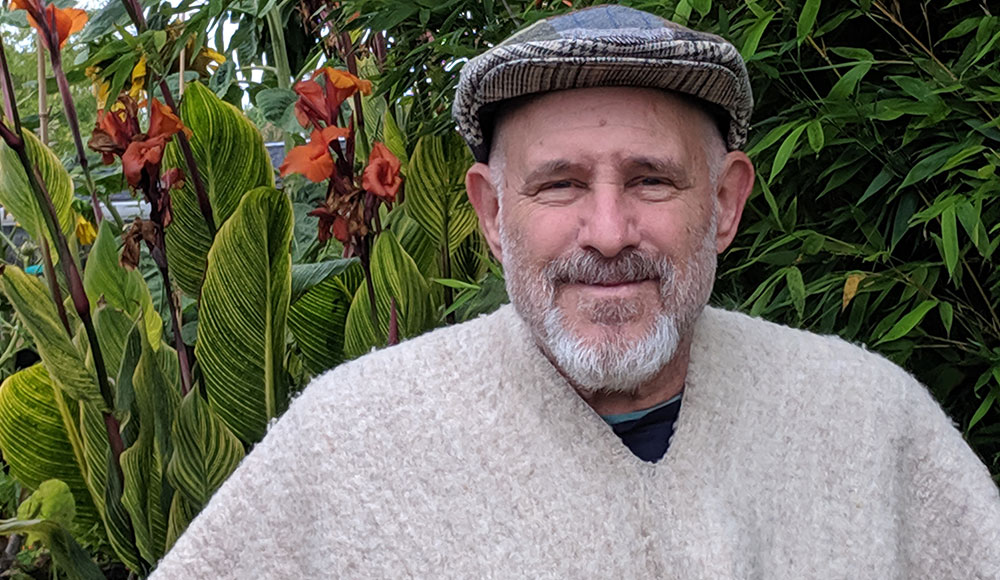At first glance meditation might sound simple—sit still, stay present, focus on your breath, tame that nagging inner voice. It just as quickly becomes clear that sitting still and staying present is harder than you think. Studies have been done on this, and given the choice between sitting in silence and an electric shock, most participants apparently assumed the mental anguish of a quiet mind would be worse.
Yet, this exercise of silently sitting still is the practice local meditation teacher Bob Stahl, Ph.D has been delivering to Santa Cruz for the past 30 years. And today, he says, these teachings are more important than ever.
As I was preparing to interview Dr. Stahl, I did a quick search to learn more about his work. That’s when I became confused. His name came up in association with Rhode Island’s Brown University, New York’s Omega Institute and other renowned East Coast retreat centers. Did I have the right guy?
Turns out I did. Stahl’s résumé reads like a who’s who of mindfulness history, blending decades of experience in meditation, psychology and teaching. A leader in Mindfulness-Based Stress Reduction (MBSR), and founder of multiple MBSR programs in major medical centers, he’s trained with some of the most respected names in the field, including Jon Kabat Zinn, credited with establishing the practice.
Although Stahl is retired these days, I was lucky enough to attend a recent session he filled in for at Insight Santa Cruz, the Buddhist meditation center located on Front Street next to Trader Joe’s. More on that in a minute.
Back to the Zoom interview. Getting right down to business, I introduced myself by sharing a story of a friend. Ten years ago, she convinced her husband to attend one of the free mindfulness orientation sessions Stahl offered at Dominican.
At that time he offered a mainstream version of meditation especially for newcomers, minus the Buddha-speak. My friend hoped attending a session would help type-A+ husband to develop more patience, or at least take his typical angst down a notch.
The experiment was a flop. The husband reported being ready to lose it by the time he completed the slow, mindful walk he’d been assigned—a traverse from one side of the room to the other. He even complained that Stahl’s calming vocals invoked more ire than tranquility.
Although I didn’t disclose this level of detail in my interview with Dr. Stahl, I hoped I was able to communicate the sentiment many of us feel at a lesser level. We in no way have time to sit still and do nothing. And sitting down when your mind is racing is more stressful than just running around and getting #hit done. I ended my brief account with a question.
“Is meditation a practical approach for the everyday person trying to manage stress?”
Stahl answered by describing what he called MSBR-founder Jon Kabat Zinn’s deepest intention: “to help alleviate suffering from anyone living with stress, pain, or illness, so it’s much more in the language of the mainstream.”
He explains, “there are different underpinnings when it comes to sitting for mindfulness meditation. It’s taking the religious part out of it but bringing in the rich psychology that can really support one living with stress, pain, and illness, so you do not need to be a Buddhist to practice mindfulness.”
Stahl acknowledges that in 30 years of teaching, most people who enroll in the eight-week mindfulness-based stress reduction program often experience deep benefits, but they have to want to be there. I was surprised to hear him cite a 75% program completion rate, but he attributes that in part to the free orientation session offered prior to sign-up. Thinking back to my friend’s story, it made sense. Run if you must.
Stahl says interest in mindfulness has exponentially grown, thanks to a tremendous amount of research published in medical journals about benefits of the practice, from reducing chronic pain and anxiety to lowering blood pressure, to name a few.
Stahl notes that when he taught his very first class in 1991, at the Cabrillo College Stroke Center, he started by asking the 25 people in the room, “How many of you heard of mindfulness? Maybe two out of 25 would have raised their hands. Now when he asks that same question of the same number of people, it’s more like 23 out of 25.
He elaborates, “It may not cure illness, of course, but one can begin to learn to relate and live with the illness in a much wiser way, so it’s developing more wisdom and compassion. The heart of this practice is cultivating acceptance.”
For those of us who are stressed or in pain, and interested in learning more about mindfulness and meditation, “Where would you suggest we start?”
“Insight Santa Cruz would be a great place. They have introduction to meditation classes there. Yes, it’s in the Buddhist world, but no one here is interested in making anyone a Buddhist. And they have classes and meditation groups almost every day.”
The following day I made my way to the Galleria on Front Street to attend a free meditation session at Insight Santa Cruz from noon to 1pm. Not knowing what to expect, I arrived to a group of around 30 people present in the room, seated in wide rows of folding chairs or cross-legged atop cushions on the hardwood floor. In the background a large screen beamed rows of faces into the corner of the spacious gold-hued room.
People were my age, my kid’s age, my mom’s age. Everyone was casually dressed and looked comfortable. The large Buddha statue was the only giveaway that this wasn’t a typical contemplative workshop.
I arrived later than I’d planned, (good old Highway 1!), quietly took off my shoes and slid onto a seat near the door. Joining the group, I closed my eyes and sat in silence for what turned out to be 30 minutes. While that may sound excruciating, some say after the first 15 the mind begins to settle, and the practice begins to flow. It seemed to work.
This state of communal calm prevailed in the room until Stahl rang a series of three gentle chimes as a signal to end with some words of inspiration.
I was reminded of Bob’s description of the impact of meditation practice from our first conversation: “We want things to go a certain way. But often they don’t. How do we learn how to go with things as they are? By developing wisdom and compassion, right? And there’s more of a need for that now than ever.”
Today his voice was made audible with the help of a headset as he expressed this sentiment to the group. “Meditation is meant to give us some perspective. We can get so lost in the great turmoil that’s happening now. When we lose ourselves, it just feeds greater and greater anxiety. Sometimes we need to take care of ourselves, of our hearts, to remember that we’re part of this universe, not against it.”
I’m reminded of the prior day, when Stahl closed our interview with a story of his own. “I’ve been thinking of Carl Sagan, the astronomer who passed away some years ago. He was involved in the satellite Voyager project of taking a picture of the planet Earth from Pluto. They were actually able to get that picture.
“Sagan wrote an essay called ‘Pale Blue Dot,’ and in the picture you can see the planet Earth. It’s like speck of dust, he says, suspended in a sunbeam and, as you look beyond the vastness of the universe, you can really see there’s no one else out there to save us from ourselves.”
The message is the same. “To remember, what’s really important in life is to care for oneself and for each other.”
For more information, visit insightsantacruz.org.
Elizabeth Borelli is the author of the new book Tastes Like La Dolce Vita. Download a free 50-page Mediterranean Recipe guide at ElizabethBorelli.com.














